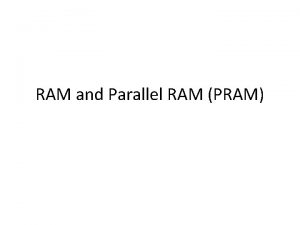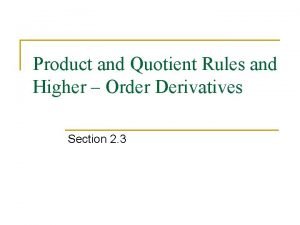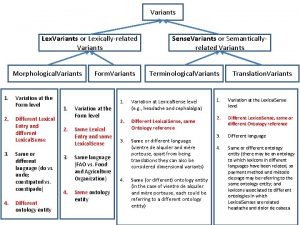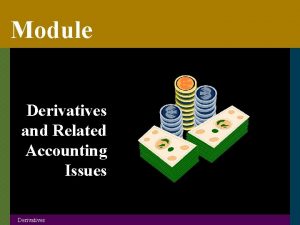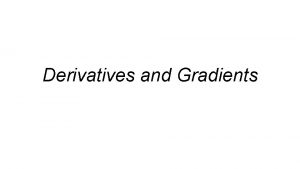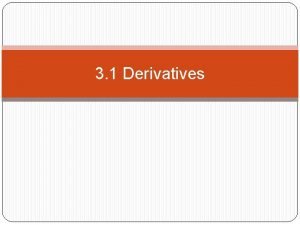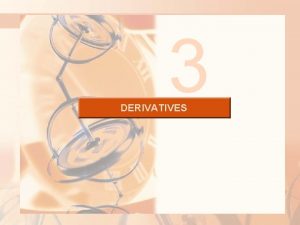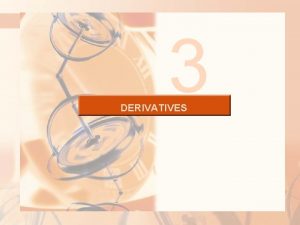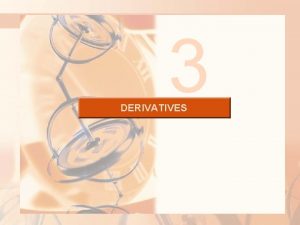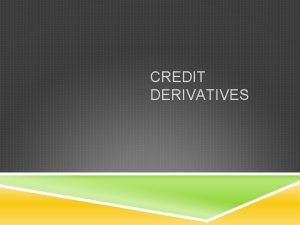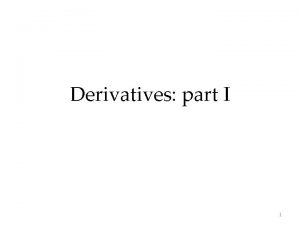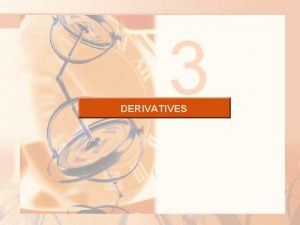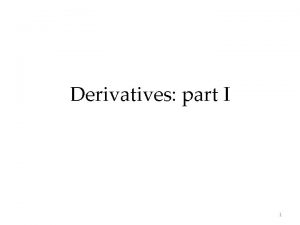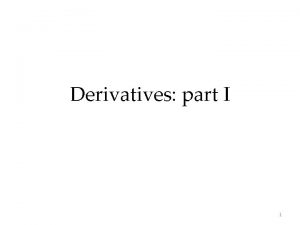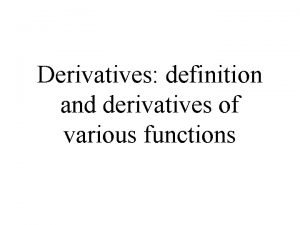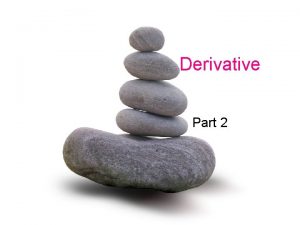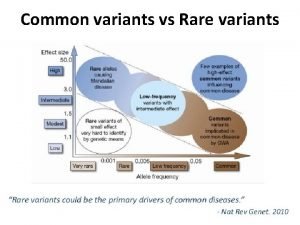Derivatives and its variants Derivative Definition A derivative


















- Slides: 18

Derivatives and it’s variants

Derivative - Definition • A derivative is a financial instrument which derives its value of some other financial instrument or variable • The value from which a derivative derives its values is called an underlier • Primary instruments or Cash Instruments are in contrast directly determined by markets • Example of derivatives: Stock Options, Interest rate swaps, equity options

Categories • Derivatives are categorized in various ways. – Linear derivatives – Non-linear derivatives • Another category – Vanilla derivatives – Exotic derivatives • Another Category – Standalone – Embedded

Standard Derivatives • • • • • • Asian option- non-linear – exotic Barrier option – non-linear – exotic Basket option – non-linear – exotic Binary option – non-linear – exotic Call option – non-linear – vanilla Cap – non-linear – vanilla Chooser option – non-linear – exotic Compound option – non-linear – exotic Contingent premium option – non-linear – exotic Credit derivative – non-linear – exotic Floor – non-linear – vanilla Forward – linear – vanilla Future – linear – vanilla Lookback option – non-linear – exotic Put option – non-linear – vanilla Quanto – non-linear – exotic Rainbow option – non-linear – exotic Ratchet option – non-linear – exotic Swap – linear – vanilla Swaption – non-linear – vanilla Strangle – non-linear – exotic Straddle – non-linear – exotic Condor – non-linear – exotic Bermudean option – non-linear - exotic

Derivatives - Categorization • • Standard derivatives are listed Categorization is not firm Usually rainbows are considered exotic Generally spreads and swaps are considered vanilla

Swap • A swap is a cash-settled simple form of OTC derivative • A swap is an agreement between two counterparties to exchange two stream of cash flows • The present values are equal • Primary reason – hedging and/or speculation • Change the character of asset without liquidation

With a Swap, You can change the Character of an Asset without having to liquidate the asset Cash Flow Stream A You Cash Flow Stream B Original Counterparty Cash Flow Stream A Swap Counterparty Cash flow from Stream from a counterparty is exchanged for Cash flow from a swap counterparty

Characteristics of a Swap • When first entered it has zero market value • Swap gains positive or negative value over time – Market variables that affect the cash flow streams – Payment conditions • Risks associated with swaps – Market Risk – Settlement Risk – Liquidity Risk – Pre-settlement Risk

Swaps – Types • Vanilla Swaps – any swap with standardized provisions for example – Vanilla interest rate swaps – Vanilla currency swaps • • • Asset Swaps Liability Swaps Interest Rate Swaps Currency Swaps Total Return Swaps

Swaps - Categories • • Equity Swap Credit Default Swap Forex Swap Currency Swap Constant Maturity Swap Volatility Swap Basis Swap Variance Swap

Interest Rate Swap Floating Rate Cash Flows Corporation Fixed Rate Cash Flows Lender Floating Rate Cash Flows Swap Counterparty By entering into a swap with a third party, a corporation can convert floating rate payments into fixed rate payments

Interest Rate Swap - Contd • Vanilla interest rate swaps – Fixed rate loan is exchanged for floating rate loan – Most common are 3 -month or 6 -month Libor rate (Euribor if the currency is Euro) floating rate – Basis swap is floating-floating interest rate swap • Concurrent cash flows are netted • Both loans have initial payments of principal – also called the notional amount – they net to zero • Final payments net to zero • Generally periodic payments are scheduled on the same date so they can be netted

Interest Rate Swap - Contd • Vanilla interest rates are quoted in terms of the fixed rate to be paid against the floating index – For example: 4. 3% against a 3 -month Libor paid quarterly • In USD markets, vanilla swaps are often quoted, not as an absolute rate, but as the fixed rate’s spread over the corresponding treasury yield • Fixed rates on vanilla swaps are called swap rates • Swap curve is a yield curve comprising swap rates for different maturities of the swap • Due to high liquidity in the USD swap market, the swap curve has emerged as an alternative to treasuries as a benchmark for USD interest rates at maturities exceeding a year

Example for Interest Rate Swap Two Banks enter into a vanilla interest rate swap. The term is four years. They agree to swap fixed rate USD payments at 4. 6% in exchange for 6 -month USD Libor payments. At the outset, the fixed rate payments are known. The first floating rate payment is also known. But the net would depend on the future of Libor. Let’s calculate the payments for the life of the swap using hypothetical values

Cash flows during the life of a hypothetical Swap USD 100 MM 4. 6% Four year Swap Time (Years) 6 -Month Libor Fixed Rate Cash Flows Floating Rate Cash Flows Swap Net Cash Flows 0. 0 2. 8% -100. 00 0. 5 3. 4% 2. 3 1. 4 0. 9 1. 0 4. 4% 2. 3 1. 7 0. 6 1. 5 4. 2% 2. 3 2. 2 0. 1 2. 0 5. 0% 2. 3 2. 1 0. 2 2. 5 5. 6% 2. 3 2. 5 -0. 2 3. 0 5. 2% 2. 3 2. 8 -0. 5 3. 5 4. 4% 2. 3 2. 6 -0. 3 4. 0 3. 8% 102. 3 102. 2 0. 1 Note: at 4. 0, we did not calculate using the 3. 8% libor rate

Equity Swap • Contractual agreement to exchange cash flows on specific assets for a given period • Based on a specific equity, equity index (Dow Jones, S&P 500 etc), or basket of equities • Notional amounts are not exchanged only cash flows • Benefits: No ownership of underlying, transaction/dividend taxes, limitations of ownership & leverage, exposure to markets

Example of Equity Swap • On December 15 of a given year a money management firm enters into a swap to pay the return on the NASDAQ Composite index and receive the return on the S&P 500 with payments to occur on March 15, June 15, September 15, and December 15 for one year. Payments will be calculated on a notional principal of $20 million.

Hypothetical Payments on One-Year Equity Swap with Quarterly Settlement to Pay the NASDAQ Return and Receive the Return on the S&P 500 on Notional Principal of $20 Million Date S&P 500 Index Periodic Return on S&P 500 Cash Flow December 15 1105. 15 March 15 1129. 48 2. 2015% $440, 300 June 15 1084. 30 -4. 0001% September 15 1055. 29 December 15 1099. 52 NASDAQ Index Periodic Return on NASDAQ Cash Flow Net Cash Flow 1750. 78 2. 6543% -$530, 860 -$90, 560 -800, 020 1689. 25 -3. 5144% +702, 880 -97, 140 -2. 6755% -535, 100 1609. 67 -4. 7110% +942, 200 407, 100 4. 1913% 838, 260 1678. 51 4. 2767% -855, 340 -17, 080 1705. 51
 Reactions of benzene and its derivatives
Reactions of benzene and its derivatives Variants of judaism
Variants of judaism Hemoglobin variants
Hemoglobin variants Efficient variants of the icp algorithm
Efficient variants of the icp algorithm Efficient variants of the icp algorithm
Efficient variants of the icp algorithm Parallel ram
Parallel ram Variants of english language
Variants of english language Copy number variants
Copy number variants Luke gill
Luke gill The bright filled paperweight
The bright filled paperweight Its halloween its halloween the moon is full and bright
Its halloween its halloween the moon is full and bright What is higher order derivatives
What is higher order derivatives Product and quotient rules and higher order derivatives
Product and quotient rules and higher order derivatives When a train increases its velocity, its momentum
When a train increases its velocity, its momentum Rainy sunny cloudy windy
Rainy sunny cloudy windy If its square its a sonnet summary
If its square its a sonnet summary Its not easy but its worth it
Its not easy but its worth it Thickening agents for sauce
Thickening agents for sauce Post trematic
Post trematic





